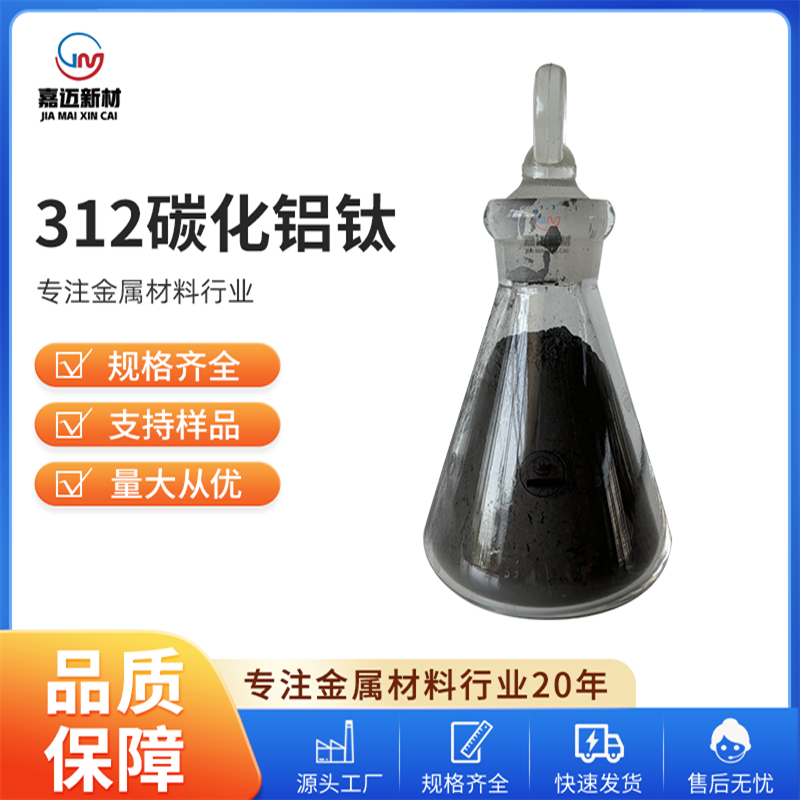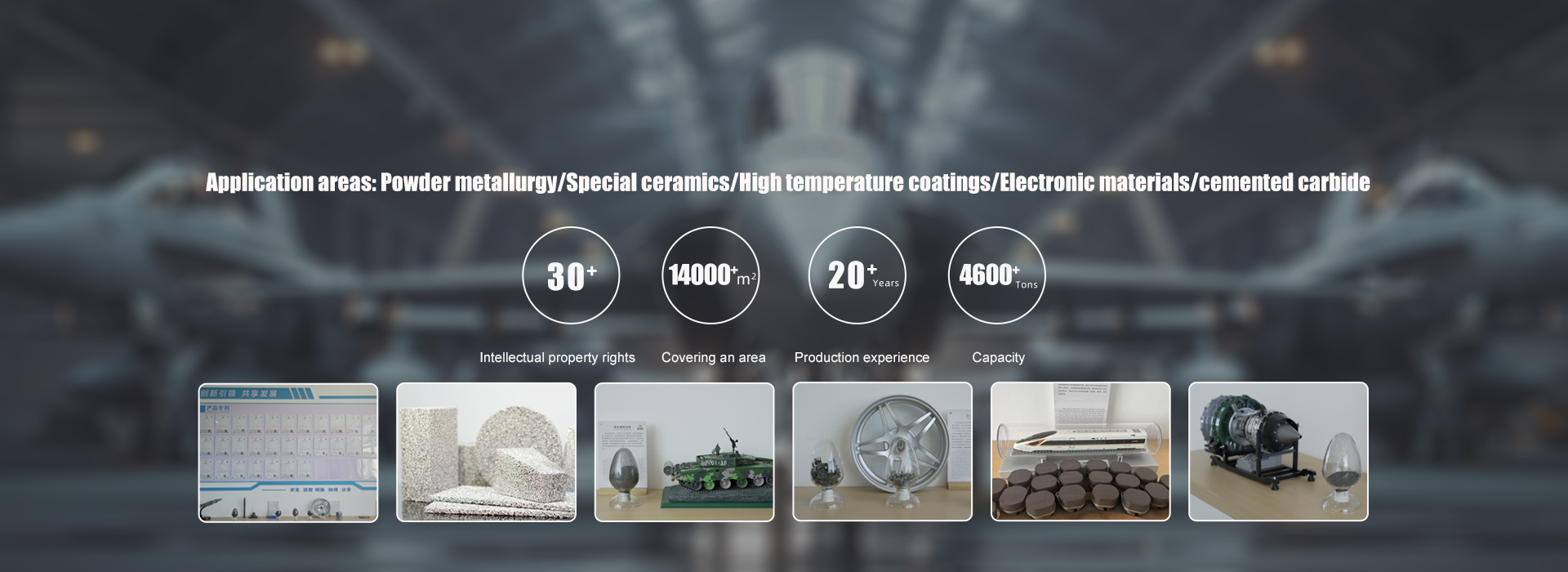
1. Introduction
In 2011, Professor Yury Gogotsi and Professor Michel Barsoum from Drexel University in the United States [1] successfully prepared a novel two-dimensional carbide crystal Ti3C2Tx (where T represents functional groups such as - F and - OH) by chemically stripping the ternary layered carbide Ti3AlC2 using hydrofluoric acid (Figure 1).
Figure 1 Schematic diagram of the atomic structure of the first Mxene material
Ti3AlC2 is a typical MAX phase. MAX phase is a general term for a class of ternary layered compounds with a unified chemical formula Mn+1AXn, where M is an early transition metal, A is a group III or IV element, and X is C or N, n = 1、 2. Grade 3. The structural characteristics of MAX phase are the alternating arrangement of M atoms and A atomic layers, forming a nearly dense hexagonal layered structure. X atoms are filled in the octahedral voids, and the M-A bond has the characteristics of a metal bond, with weaker interaction force compared to the M-X bond.
Therefore, in hydrofluoric acid solution, the A atomic layer of MAX phase is easily etched, and the remaining M and X atomic layers form two-dimensional Mn+1Xn atomic crystals. To emphasize that they are peeled off from MAX phase and have a two-dimensional structure similar to graphene, they are collectively named MXene. Based on various combinations of transition metals such as Ti, Mo, V, Cr, and their alloys with C and N, material scientists have identified or predicted the stable phases of hundreds or thousands of different MXenes.
Experimental and theoretical studies have shown that these materials have excellent mechanical, electrical, optical, and electrochemical properties, demonstrating outstanding potential for energy conversion and electrochemical storage. They have enormous application potential in fields such as lithium/sodium ion batteries, supercapacitors, photocatalysts, solar energy utilization, biomedicine, and sensors.
As MXenes materials become increasingly popular and frequently appear in top journals such as Science, Nature, JACS, AM, etc., the application of MXenes materials has also increased year by year with the growth of the MXenes family. The number of journal publications related to MXenes materials has also rapidly increased, indicating that research on MXenes has been thriving in recent years (Figure 2).
Figure 2 Statistics of articles and domestic and foreign patents related to MXenes from the "Web of Science" website
As is well known, graphene has been the most promising material in the field of two-dimensional materials research in the past few years. However, the practical application of graphene is limited by its simple chemical composition, as it only contains a carbon network. In addition, the lack of different surface functional groups on graphene and its expensive cost have hindered its development. MXenes, as a novel type of two-dimensional material, have a near metallic conductivity (reported to be as high as 9880 S/cm), combined with excellent hydrophilicity, which overcomes the defect of graphene losing its conductivity severely when oxidized or surface modified. Therefore, MXenes have been warmly sought after by researchers from various countries and are gradually becoming the most eye-catching two-dimensional material in the 21st century.
2. Preparation method of Mxenes material
With the growth of the MXenes family, research on MXenes materials is also increasing. Figure 3 presents a brief timeline of the progress in discovering MXenes materials. It can be seen that in recent years, the development speed of MXene materials has been increasing rapidly, and the process flow for preparing MXene materials has also become increasingly diverse, gradually evolving from using highly toxic and corrosive HF solutions to using richer, greener, and healthier methods and processes such as molten salt, high-temperature alkaline solutions, and electrochemical stripping [2].
Figure 3 Preparation process of Mxenes material
Fluorinated solution etching: Currently, solutions containing F - ions are the most commonly used etchants for preparing MXenes, and fluorine-containing etchants can be mainly divided into two categories: acidic solutions containing fluoride ions (such as HF solutions, mixtures of LiF and HCl, or NH4HF2 solutions) and salt solutions containing fluoride ions (NH3F, KF, LiF, or NaF). Firstly, immerse the MAX phase in a solution of F - ions to break the M-A bond, and then separate the MXene from the mixed solution. During this process, a certain amount of corrosion time is required and thorough stirring is necessary. Initially, Naguib et al. synthesized the first carbon based MXene by immersing Ti3AlC2 powder in concentrated hydrofluoric acid solution. Meanwhile, considering the harm of HF solution to human body and environment, scientists have successively developed safer mixtures of LiF and HCl or NH4HF2 solution as etchants, and successfully prepared different MXenes materials.
Alkaline solution chemical etching: The most effective etching agent for preparing MXenes materials through MAX precursor is a solution containing fluoride ions. Although this method is effective, it has the following drawbacks: it poses a significant threat to human health and the environment; And inert fluorine functional groups can reduce material properties (such as capacitance, etc.); In addition, HF solution not only corrodes the Al layer, but also corrodes the transition metal elements in the MXene structure; More importantly, certain etching by-products are insoluble in any solvent under mild conditions and are difficult to remove from the prepared MXene. Therefore, there is an urgent need for a new fluorine free method to remove atoms from the "A" layer. Through research, it has been found that when using solutions containing fluoride ions, the fluoride ions attack and remove alkaline or amphoteric elements rather than acidic elements. Therefore, solutions containing fluoride ions can etch the MAX phase with most of the "A" atoms being Al and Ga to synthesize MXenes materials. Due to the strong binding ability between alkali and the amphoteric element Al, theoretically it is also feasible to use alkaline solution to etch MAX with Al element in the "A" layer.
Electrochemical etching: Scientists have demonstrated that the corresponding MXenes (Ti2CTx) phase can be prepared from Ti2AlC by electrochemical method in aqueous HCl solution. Compared with the chemical etching method using a mixed solution of HF or LiF and HCl, this electrochemical etching method does not contain any fluoride ions during the etching process, and the prepared MXenes surface will only contain - Cl- O and - OH groups. Further research has found that Ti2AlC will be electrochemically etched into a three-layer structure. From the outside to the inside, this structure is composed of carbon derived from carbides, MXenes, and unetched MAX. And MXenes can be further separated from this three-layer structure by ultrasound, thus obtaining pure MXenes. This result successfully demonstrates that electrochemical etching can selectively remove layer A from MAX phase without the use of fluoride ions, forming MXenes materials without - F groups. Therefore, this method also has potential application prospects.
Molten salt etching: Late transition metal halides (such as ZnCl2) are Lewis acids in their molten state, and these molten salts can produce strong electron accepting ligands that can undergo thermodynamic reactions with the A element in MAX. Meanwhile, the surrounding Zn atoms or ions can diffuse onto the two-dimensional atomic plane and bond with unsaturated Mn+1Xn nanosheets to form the corresponding MAX phase. Afterwards, excessive ZnCl2 can etch the newly formed MAX to generate MXene. Multiple novel MAX phases (such as Ti3ZnC2, Ti2ZnC, Ti2ZnN, and V2ZnC) and corresponding MXenes have been successfully synthesized using this method.
Although the current methods for preparing two-dimensional MXene materials can be mass-produced, the large number of functional groups generated during the etching process seriously affects the performance of MXene materials. For example, MXenes without functional groups exhibit metallic properties, while MXenes with functional groups are semiconductors. Therefore, how to prepare pure MXenes materials is an important research direction in the future. In addition, MXenes materials prepared by different methods have different structures and morphologies, and appropriate methods should be selected according to the needs.
3. Application analysis
The unique physicochemical properties of MXenes materials have attracted widespread attention from the academic community in various fields such as energy storage and conversion, sensors, biomedicine, and multifunctional polymer composites in recent years. Figure 4 shows the common applications of MXenes. In order to further illustrate them, the author has provided a detailed summary of some of the "hot" application areas.
Figure 4 Common application areas of Mxenes materials
3.1 Energy Storage
Rechargeable secondary batteries have significant competitive advantages in alternative energy storage, demonstrating high theoretical capacity and energy density. The use of low-cost sodium or potassium ions rich in Earth to form Na ion batteries (SIB) or K ion batteries (PIB) is expected to replace existing lithium-ion batteries (LIB). However, due to the slow kinetics of the electrochemical reaction process, its battery performance is still unsatisfactory, which is caused by the large ionic radii of Na+and K+and the severe volume expansion associated with their insertion and extraction. Therefore, there is an urgent need to explore high-performance electrode materials to promote the movement and storage of larger alkali metal ions, improve battery performance, and meet the standards required for commercialization.
Han Wei et al. from Jilin University [3] used in situ biological adsorption strategy to MXene@N The doped carbon nanofiber structure is designed as the anode for high-performance sodium and potassium ion batteries. Assemble Ti3C2Tx nanosheets onto Aspergillus niger to generate fungal nanoribbons and convert them into 2D/1D heterostructures. This two-dimensional MXene-1D nitrogen doped carbon nanofiber structure derived from microorganisms has completely open pores and transport channels, high reversible capacity, and long-term stability, and can store Na+(349.2 mAh g-1 at 0.1 A g-1 cycles for 1000 times) and K+(201.5 mAh g-1 at 1.0 A g-1 cycles for 1000 times) (Figure 5). Ionic diffusion kinetics analysis and density functional theory calculations indicate that this porous hybrid structure promotes the conduction and transport of Na and K ions, fully utilizing the inherent advantages of two-dimensional materials. Therefore, this study expands the potential of MXene materials and provides a good strategy for addressing the challenges of two-dimensional materials in energy storage applications.
Figure 5 Synthesis and Electrochemical Properties of MXene Electrode Materials
3.2 Catalysis
Photocatalytic water splitting is expected to achieve large-scale and sustainable solar hydrogen production. The earliest semiconductor materials used had low hydrogen production activity. In recent years, the development of Pt based co catalysts has effectively improved the hydrogen production activity and stability of photocatalysts, but the cost is relatively high. Therefore, developing high activity, abundant reserves, and low-cost co catalysts to achieve clean and sustainable hydrogen production is a glorious and urgent task.
So far, high activity, abundant reserves, and low-cost co catalysts still have at least the following problems: 1) It is difficult to establish strong correlation between the co catalyst surface and the photocatalyst surface, which is not conducive to interfacial charge transfer and long-term stability. 2) The poor conductivity of co catalysts or the disruption of π - conjugated systems result in low internal electron shuttle efficiency. 3) Gibbs free energy is not conducive to hydrogen evolution. 4) Insufficient hydrophilic functionality leads to insufficient contact with water molecules. 5) Stability is insufficient and sometimes needs to be in a non-aqueous environment. MXenes, as a new type of two-dimensional material, have shown great potential in solving the above problems: 1) MXenes surface contains a large amount of - OH and - O, which can establish strong correlation with various semiconductor surfaces. 2) Good conductivity contributes to efficient charge carrier transfer. 3) The exposed metal sites at the terminal may result in MXene having stronger redox activity than carbon materials. 4) Good hydrophilicity ensures sufficient contact with water molecules. 5) Can exist stably in water.
Figure 6 (a) Structural model; (b) Comparison of hydrogen production activity; (c) UV Visible Diffuse Reflectance Spectroscopy
As shown in Figure 6, Qiao Shizhang's research group [4] synthesized a highly efficient co catalytic MXene material, Ti3C2 nanoparticles, guided by DFT theoretical calculations. Researchers integrated Ti3C2 nanoparticles onto the surface of the light absorbing material CdS using a hydrothermal method, achieving visible photocatalytic hydrogen production with an activity of up to 14342 μ mol h-1 g-1, and an apparent quantum efficiency of 40.1% at 420 nm (Figure 6b). This research achievement is the first to introduce MXene as a co catalyst into the photocatalytic hydrogen production system, demonstrating the enormous potential of MXene in replacing Pt and constructing low-cost, high-performance photoelectrodes or photocatalysts.
3.3 Optical components
Displays with self luminous display characteristics have a wide range of application prospects, such as OLED (organic light-emitting diode) displays used in Apple phones and QLED (quantum dot light-emitting diode) displays used in LG TVs, which have now begun commercial use. Unlike traditional LCD display methods, this type of display technology does not require backlighting and uses very thin organic, quantum dot, or polymer material coatings and glass substrates. When current passes through, these materials can self emit light, making them lighter, thinner, with a larger viewing angle, and significantly reducing power consumption.
MXene, as a two-dimensional transition metal carbide and nitride material with high conductivity and optical transparency, has a shape similar to stacked potato chips. At present, this type of material has been applied in multiple fields such as energy, catalysis, medicine, etc., and has attracted worldwide attention. However, there is still no relevant exploration on whether this material can be applied in the field of light-emitting diodes.
Professor Cheolmin Park from Yonsei University in South Korea [5] used MXene material as a polymer light-emitting diode (PLED). As a solution treatable, large-area, flexible, and transparent PLED based on MXene material, it exhibits unprecedented high performance. As shown in Figure 7, under optimal AC conditions, the switching voltage, current efficiency, and brightness of the PLED can reach 2.1 V, 7 cd A-1, and 12547 cd m-2, respectively. The excellent performance of MXene material on PLED is superior to currently reported carbon nanotubes, reduced graphene oxide, and Ag nanowires, making it highly promising as the next generation of flexible and transparent display materials.
Figure 7 (a) Schematic diagram of MXene PLED; (b) Cross sectional TEM image; (c) Energy level schematic diagram; (d) L-V characteristics; (e) Current efficiency;
(f-g) The relationship between maximum brightness and current efficiency and frequency; (h) Capacitance of different electrodes
3.4 Biopharmaceuticals
As of now, the COVID-19 pandemic remains a major global crisis. Although respiratory symptoms are a key feature of this disease, many people hospitalized for COVID-19 also suffer from acute kidney injury, which exacerbates the patient's mortality rate and may require treatment through continuous kidney replacement methods. During the pandemic, the focus on hospital capacity was mainly on whether there were sufficient ventilators. However, in this epidemic, the hospital's dialysis treatment supplies, including dialysate, are severely inadequate. Therefore, there is an urgent need to develop materials that can effectively and rapidly regenerate dialysate, remove toxins, and restore electrolyte concentration, in order to maintain sufficient supply of this important resource.
Professor Yury Gogotsi's team from Drexel University in the United States [6] used Ti3C2Tx, an MXenes material known to effectively adsorb urea, to remove creatinine and uric acid from aqueous solutions and dialysate, with maximum adsorption capacities of 45.7 and 17.0 mg g-1, respectively. The author systematically analyzed and simulated adsorption kinetics, isotherms, and thermodynamics to determine the rate limiting steps and adsorption mechanism, and designed a fixed bed column containing Ti3C2Tx to further evaluate the adsorption performance under continuous fluid flow conditions, reflecting the conditions of continuous renal replacement therapy. This study indicates that Ti3C2Tx has the potential to serve as an effective adsorbent for dialysate regeneration, accelerating dialysate regeneration by removing filtered toxins and achieving more portable manufacturing of dialysis equipment, demonstrating the potential application of MXenes materials in the pharmaceutical field (Figure 8).
Figure 8 Schematic diagram of Ti3C2Tx, creatinine, and uric acid and their adsorption processes
3.5 Gas Sensing
Prevention is the best way to treat diseases. Early detection before the disease worsens may provide more treatment opportunities and increase the likelihood of patient survival. One direction for early prevention is continuous physiological monitoring of the human body through respiration, heart rate, and skin. It is worth noting that approximately 200 compounds have been detected in human respiration, some of which gases can reflect the health status of the body. Therefore, utilizing gas detection and accompanying respiratory analysis will be a practical medical method.
At the same time, these gas sensors should be equipped with other functions such as portability, wearability, flexibility, etc. However, existing traditional gas sensors are made on solid substrates, so they cannot be made into wearable electronic devices. In addition, commercially available metal oxide sensors cannot operate at room temperature. Therefore, it is necessary to develop new materials with good room temperature sensing performance on flexible substrates, and two-dimensional materials are theoretically predicted to have excellent room temperature gas sensing performance.
Professor Dong Joo Kim from Auburn University [7] first reported a gas sensor based on Ti3C2Tx and used it to test ethanol, methanol, acetone, and ammonia gas. The author prepared the synthesized Ti3C2Tx nanosheets on flexible polyimide films using an easy-to-use solution casting method and studied their surface chemical properties. As shown in Figure 9, the Ti3C2Tx sensor successfully detected gases such as ethanol, methanol, acetone, and ammonia at room temperature, exhibiting p-type sensing behavior. Due to the high absorption energy of Ti3C2Tx sensor, it has a high sensing response to ammonia gas. The possible sensing mechanism of the sensor is proposed based on the majority charge carrier transfer generated by the interaction between sensing materials. This new type of Ti3C2Tx gas sensor will be a next-generation universal sensor for future wearable electronic devices, with performance comparable to other 2D material sensors, providing a new direction for the application of MXenes materials in sensors.
Figure 9 Gas detection results of Ti3C2Tx at room temperature
4. Summary and Prospect
Since its discovery, MXenes have been widely used in fields such as energy storage, catalysis, and sensors due to their excellent electrical, optical, electrochemical, and mechanical properties. After nearly a decade of extensive research, although MXenes materials have made great progress in preparation, structure, and application, there are still many problems in the research process.
For example, in terms of preparation: (1) simulation and calculation of the structure, properties, etc. of different MXenes can provide guidance for the efficient preparation and practical application of MXene materials, but still require a large number of experiments to verify; (2) Due to the large number of functional groups loaded on the surface of MXenes prepared by chemical methods, there is still a long way to go in exploring more physical preparation methods, such as CVD; (3) At present, the MXene layers prepared are relatively thick, and the yield of single-layer or few layer MXene is very low. Therefore, it is necessary to seek more efficient preparation or separation methods to obtain MXene materials with different layers and properties, and there is still a long way to go.
In terms of applications, although MXenes materials have great prospects in many fields, they are prone to self aggregation and stacking due to size effects, which greatly affect the performance of the materials. Although inorganic metal ions, organic molecules, polymer molecules, and CNTs can be inserted between two-dimensional nanomaterial layers to reduce self aggregation, increase active reaction sites, and improve the transport rate of electrolyte ions in electrode materials, the transport rate of ions decreases exponentially with the increase of electrode material thickness.
Finally, as a new type of two-dimensional material that combines multiple excellent properties, MXenes not only requires the development of more efficient preparation methods, but also the discovery of other properties, while continuously exploring more potential application areas in its development and research process.








